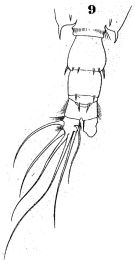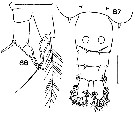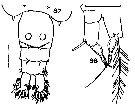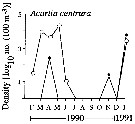|
|
 |
Fiche d'espèce de Copépode |
|
|
Calanoida ( Ordre ) |
|
|
|
Diaptomoidea ( Superfamille ) |
|
|
|
Acartiidae ( Famille ) |
|
|
|
Acartia ( Genre ) |
|
|
|
Odontacartia ( Sous-Genre ) |
|
|
| |
Acartia (Odontacartia) centrura Giesbrecht, 1889 (F,M) | |
| | | | | | | Syn.: | no Acartia centrura : Tranter & Abraham, 1971 (p.223, fig.M). | | | | Ref.: | | | Giesbrecht, 1892 (p.508, 523, 770, figs.F,M); Giesbrecht & Schmeil, 1898 (p.155); Wolfenden, 1911 (p.357); Sewell, 1914 a (p.240); Steuer, 1923 (p.27, figs.F,M); Sewell, 1924 (p.790); 1932 (p.396); Wellershaus, 1969 (p.273, figs.F); Goswami & Goswami, 1973 (p.242, fig.1, karyotype); Berdugo, 1974 (p.85, Rem.); Abraham, 1976 (p.73, 79, figs.F,M); Bradford-Grieve & al., 1999 (p.886, 962, figs.F,M); Srinui & al., 2019, p.90, Rem. F, M); Lee S. & al., 2019 (p.86, Table 3). |  issued from : W. Giesbrecht in Fauna Flora Golf. Neapel, 1892, 19. [Taf.43, Fig.9]. Male: 9, thoracic segment 5 and urosome (dorsal).
|
 issued from : W. Giesbrecht in Fauna Flora Golf. Neapel, 1892, 19. [Taf.30, Fig.31]. Male: 31, P5.
|
 issued from : W. Giesbrecht in Fauna Flora Golf. Neapel, 1892, 19. [Taf.30, Fig.26]. Female: 26, P5.
|
 Issued from : S. Wellershaus in Veröff. Inst. Meeresforsch. Bremerh., 1969, 11 (2). [p.274, Fig.86-87]. Female (from Cochin Backwater, S. India): 86, P5 (terminal spines seen in two different aspects); 87, last thoracic segment and urosome (dorsal). Nota: The specimens tend to reduce or loose spines on the urosoal segments 1-3. In some females segment 9 of A1 bears one ot two small spinules near the distal margin on the posterior side.
Scale : single line = 0.1 mm ; double line = 0.05 mm.
|
 issued from : S. Abraham in Crustaceana, 1976, 30 (1). [p.75, Figs.4-6]. Female (from Cochin, India): 4, urosome (dorsal); 5, P5; 6, right A1.
|
 issued from : S. Abraham in Crustaceana, 1976, 30 (1). [p.76, Figs.13-16]. Female: 16, Md (masticatory edge). Male (from eastern Mediterranean): 13, posterior part of last thoracic segment and urosome (dorsal); 14, P5 (posterior view); 15, right A1.
|
 issued from : S. Abraham in Crustaceana, 1976, 30 (1). [p.79, Table I]. Comparative list of characters female of A. bowmani and A. centrura.
|
 issued from : S. Abraham in Crustaceana, 1976, 30 (1). [p.79, Table II]. Comparative list of characters male of A. bowmani and A. centrura.
|
 Issued from : S. Wellershaus in Veröf. Inst. Meeresf. Bremerhaven, 1969, XI. [p. 274, Fig. 86-87]. Female (from Cochin Backwater and outlet, W Thevara): 86, P5; 87, urosome (dorsal). Nota: - Ratio prosome : urosome 3.8 yo 4.1. - Proportions of the abdominal segments plus caudal rami: 43 : 23 : 6 : 25 = 100.
|
 Remark: Erratum concerning the name: read Srinui and not Siruani. Female: 1 - Genital double-somite having paired posterodorsal processes. 2 - 2nd segment of A1 without strong curved processes. 3 - Exopod of P5 thickened proximally, extending midway along exopod. Male: 1 - Urosomite 3 with large spine-like processes dorsally. 2 - Dorsal processes of urosomite 3 short, reaching posterior-most border of urosomite 4. 3 - Urosomites 3 and 4 each with 2 prominences between pair of dorsal processes.
|
 Issued from : S. Lee, H.Y. Soh & W. Lee in ZooKeys, 2019, 893. [p.84, Table 3]. Acartia (Odontacartia) centrura: Morphological characters. Compare with other Odontacartia species. Nota: 1 - Absence of spine on 1st to 2nd segments of female A1 .....2. 2 - Spine present on dorsal surface of female genital double-somite ..... 3. 3 - Dorsal surface of female genital bouble-somite and 2nd urosomite with 2 strong spines .....4. 4 - Female P5 outer seta longer than terminal spine ..... 5. 5 - Length-width ratio of female caudal rami as 1.7; medial process on 2nd exopodite male left P5 as spine.
| | | | | Ref. compl.: | | | Thompson & Scott, 1903 (p.236, 254); Gurney, 1927 (p.155, Rem.); Sewell, 1948 (p.324, 431, 461); Delalo, 1968 (p.138); Patel, 1975 (p.660); Moraitou-Apostolopoulou, 1985 (p.303, occurrence/abundance in E Mediterranean Sea, Rem.: p.313); Madhupratap & Haridas, 1986 (p.105, tab.2); Ramaiah & Nair, 1997 (tab.1); Nair & Ramaiah, 1998 (p.272, fig.4); Achuthankutty & al., 1998 (p.1, Table 2, fig.5, seasonal abundance vs monsoon); Mauchline, 1998 (tab.78); El-Sherif & Aboul Ezz, 2000 (p.61, Table 3: occurrence); Dalal & Goswami, 2001 (p.23, tab.2); Belmonte & Potenza, 2001 (p.173); El-Serehy & al., 2001 (p.116, Table 1: abundance vs transect in Suez Canal); Obuid Allah & al., 2005 (p.123, occurrence % vs metal conbtamination); Madhu & al., 2007 (p.54, Table 4, abundance vs monsoon); Rakhesh & al., 2008 (p.154, abundance vs stations); Cornils & al., 2010 (p.2076, Table 3); Zenetos & al., 2010 (p.397); El-Serehy & al., 2013 (p.2099, Rem.: p.2101); Varadharajan & Soundarapandian, 2013 (p.2: occurrence vs stations); Rakhesh & al., 2013 (p.7, Table 1, abundance vs stations); | | | | NZ: | 4 + 2 douteuses | | |
|
Carte de distribution de Acartia (Odontacartia) centrura par zones géographiques
|
| | | | | | | | |  Carte de 1996 Carte de 1996 | |
 issued from : C.T. Achuthankutty, N. Ramaiah & G. Padmavati in Pelagic biogeography ICoPB II. Proc. 2nd Intern. Conf. Final report of SCOR/IOC working group 93, 9-14 July 1995. Workshop Report No. 142, Unesco, 1998. [p.8, Fig.6]. issued from : C.T. Achuthankutty, N. Ramaiah & G. Padmavati in Pelagic biogeography ICoPB II. Proc. 2nd Intern. Conf. Final report of SCOR/IOC working group 93, 9-14 July 1995. Workshop Report No. 142, Unesco, 1998. [p.8, Fig.6].
Salinity ranges for A. centrura in coastal and estuarine waters of Goa (India).
Shaded area indicates the range of higher abundance. |
 issued from : C.T. Achuthankutty, N. Ramaiah & G. Padmavati in Pelagic biogeography ICoPB II. Proc. 2nd Intern. Conf. Final report of SCOR/IOC working group 93, 9-14 July 1995. Workshop Report No. 142, Unesco, 1998. [p.6, Fig.5]. issued from : C.T. Achuthankutty, N. Ramaiah & G. Padmavati in Pelagic biogeography ICoPB II. Proc. 2nd Intern. Conf. Final report of SCOR/IOC working group 93, 9-14 July 1995. Workshop Report No. 142, Unesco, 1998. [p.6, Fig.5].
Monthly occurrence of Acartia centrura in coastal (black circle) in front of Goa and and the Mandovi estuary (clear circle). |
 issued from : C.T. Achuthankutty, N. Ramaiah & G. Padmavati in Pelagic biogeography ICoPB II. Proc. 2nd Intern. Conf. Final report of SCOR/IOC working group 93, 9-14 July 1995. Workshop Report No. 142, Unesco, 1998. [p.3, Fig.2]. issued from : C.T. Achuthankutty, N. Ramaiah & G. Padmavati in Pelagic biogeography ICoPB II. Proc. 2nd Intern. Conf. Final report of SCOR/IOC working group 93, 9-14 July 1995. Workshop Report No. 142, Unesco, 1998. [p.3, Fig.2].
Hydrography of the coastal station in front of Goa and Mandovi estuarine station (W India).
Nota: The seasons are arbitrarily classified into the southwest monsoon (June-September), postmonsoon (October-January) and premonsoon (February-May). |
| | | | Loc: | | | Atlant. (off N Ste Helene), E Medit (Israel coast), Suez Canal (Suez Bay, Port Taufik, Bitter Lakes: very common, Ismaïlia, Lake Timsah, El Guiar, El Kantara, El Tineh, Ras-el-Ech, not Port Said after Gurney, 1927), , Safâga, Red Sea, Oman Sea, Bombay, Mandovi-Zuari estuary, Kerala, Goa, Sri Lanka, India (NW, Saurashtra coast, Godavari estuary, Kinada Bay, Chilka Lake, Poiintcalimere, Manamelkudi, ), Burma, Indonesia (SW Celebes). | | | | N: | 26 (Atlant.: ?1; Medit.: 1; Suez Canal: 4; Red Sea: 4; N Indian: 16, Indonesia: 1) | | | | Lg.: | | | (46) F: 1,24-1,2; M: 1,03; (80) F: 1,13; M: 1,028; (172) F: 1,3-1,2; (919) F: 1,35; M: 1,25; {F: 1,13-1,30; M: 1,03} | | | | Rem.: | ± saumâtre, estuaire-néritique.
Les tailles semblent corrélées avec la salinité.
Cette forme signalée off Irlande SW par I.C. Thompson (1903 a, p.31) nécessite d’être confirmée, ainsi que la forme signalée par Dakin & Colefax (1933, p.207) en Australie (Nouvelle-Galles du Sud).
Peut-être introduit en Méditerranée à partir de la Mer Rouge.
Voir aussi les remarques en anglais | | | Dernière mise à jour : 17/04/2020 | |
|
|
 Toute utilisation de ce site pour une publication sera mentionnée avec la référence suivante : Toute utilisation de ce site pour une publication sera mentionnée avec la référence suivante :
Razouls C., Desreumaux N., Kouwenberg J. et de Bovée F., 2005-2025. - Biodiversité des Copépodes planctoniques marins (morphologie, répartition géographique et données biologiques). Sorbonne Université, CNRS. Disponible sur http://copepodes.obs-banyuls.fr [Accédé le 02 avril 2025] © copyright 2005-2025 Sorbonne Université, CNRS
|
|
 |
 |












